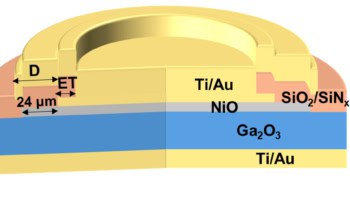Every year Britain's railway system suffers when leaves on the line cause trains to be delayed or cancelled. Matin Durrani describes how a new start-up company has developed a high-power laser system that could blast railway tracks clean.

They cause delays, cancellations and untold frustration to rail passengers in the UK every autumn. It’s no wonder that leaves on the line have become something of a national joke, regarded by the British public as merely the latest excuse for poor railway services. The problem arises whenever leaves from trees bordering the track fall close to the rails, where they are swept up by the turbulence caused by passing trains before being crushed under the wheels of the carriages. The leaves are pounded into a hard, black, shiny Teflon-like substance that is difficult to remove, even with a sharp knife. Horse chestnuts and limes are the biggest culprits, with their leaves having the highest “squidge factor”.
The problem is exacerbated during bad weather. Crushed leaves become slippery when wet, and the poor adhesion between wheel and track makes it difficult for trains to slow down and stop. Some trains require twice the usual distance to come to a halt, and their “stopping distance” can increase by anything up to 800 m, depending on the train’s initial momentum. Leaves on the line also make it more likely that trains will overshoot signals – leading to “signals passed at danger”. And heavy-goods trains can sometimes even find it impossible to pull away on leaf-covered lines, causing delays for the rail-freight industry.
Now, however, a new Hampshire-based company set up by a former Royal Navy officer could make leaves stuck to the line a thing of the past. Malcolm Higgins founded LaserThor in November 1999 after hearing a radio report about the problems facing the railway industry. “I am no scientist or railway expert”, recalls Higgins, “but it suddenly occurred to me that lasers, which are so common nowadays, ought to be able to help.” His idea was to attach a high-power laser to a train that could then clean the tracks as it moved over them. Progress has been remarkably swift since Higgins’ initial brainwave, and – thanks to help from the Rutherford Appleton Laboratory – LaserThor hopes to have its first marketable products next year.
Cleaning the tracks
In the old days of steam trains, leaves on the line were never a problem for Britain’s railways. Trees bordering lines were regularly cut back to prevent sparks from igniting the foliage. But as diesel and electric trains gradually replaced steam engines, the trees were allowed to grow so much that they began to encroach on the line. It also became common for trees to be planted to help cut train noise.
Leaves are now such a hazard that Railtrack – the company that used to maintain the UK’s rail network before being taken over by administrators last October – spent £60m in autumn 1999 tackling the problem. The money mainly went on transporting an army of manual staff around the country to clean the rails in the early hours of the morning. Britain’s rail regulator even allows train-operating companies in the worst-hit areas to reduce the number of trains during the autumn period. South West Trains, for example, which runs commuter trains into London, regularly cuts its autumn services by up to one third to allow for potential delays.
Given the extent of the leaf problem, it is surprising that most solutions adopted by the railway industry are remarkably low-tech. Traditional methods of removing leaves include blasting the tracks with high-pressure jets of water, squirting them with a gel-like sandy material known as “sandite”, or scrubbing them with scourers. Crushed orange peel has even been tried as a possible abrasive. All of these approaches, however, are slow, unreliable and expensive.
Green light for research
After his initial idea, Higgins wasted little time putting it into practice. He hired a lawyer to file a patent on his idea and paid for researchers at the Defence Evaluation and Research Agency in Malvern to see if rails could be cleaned with lasers without causing damage. “They said that it could be done in principle, but that it wasn’t practical for a real railway system,” recalls Higgins. “I also knew that the laser would have to work on a moving train for my idea to be viable.”
Higgins then persuaded Railtrack to look into his idea. Despite being notoriously cautious about the potential of new technology, the company’s managers were keen. They helped LaserThor to obtain the necessary safety clearance to carry out trials in autumn 2000. This was just after a damaged rail caused the Hatfield rail crash, which forced Railtrack to check almost every line in the country for similar defects, paralysing Britain’s rail network in the process. “The fact that we were allowed to run trials even when Railtrack was under so much pressure to deal with the short-term problems that arose in the wake of the crash shows how enthusiastic the company was,” says Higgins.
With help from a private investor, the Rutherford Appleton Laboratory, a government SMART award worth £40 000 and an electrical engineer called Mike Davis, the trials began in autumn 2000. The Rutherford lab provided the laser expertise, while Spectron Laser Systems of Rugby in Warwickshire lent LaserThor a pulsed neodymium yttrium aluminium garnet (Nd:YAG) laser operating at 1064 nm. The laser was installed on a carriage with electrical power provided by an on-board generator. Using a carefully designed optical set-up of lasers and mirrors that could withstand the rigours of rail travel, the laser light was directed onto the track. Each intense laser pulse can produce a series of minute explosions that blow the leaf residue off the rails, resulting in a clean track and restoring traction to passing trains.
“We found that it was entirely feasible to use lasers to remove rail contamination without damaging the track and that we could operate successfully with the train running at speeds of about 8 kilometres per hour,” says Higgins. The tests also showed that leaf residue can make or break a railway’s safety circuit, which is formed between the track, trains and the signalling equipment. “Our trials proved that high levels of leaf contaminant can cause signalling systems to miss the presence of trains on the track. Signals then have to be changed manually, which is dangerous. Lasers could also solve this problem.”
Full steam ahead
Following the success of these early trials, LaserThor then began investigating how a laser system could work on trains running at more realistic speeds of about 70 kilometres per hour. Higgins contacted the Fraunhofer Institute for Laser Technology in Aachen, Germany, who built a high-power 1 kW Nd:YAG laser that could be fitted into a 1 m3 box. The unit contains the hardware required to support the laser in the hostile railway environment, including a chiller and electrical power-control devices. The new laser system has a higher pulse rate than the original and uses fibre optics – rather than lenses and mirrors – to deliver the laser beam onto the track. The system was used in further trials last autumn.
LaserThor has also carried out lab experiments to see if exposing a railway track to intense laser light damages the track in any way. Sections of rail were exposed to a number of laser shots over a range of intensities and then sent for metallurgical analysis. The results have, happily, revealed no significant damage to the surface of the track under normal conditions. “We are well within the safety range,” says Higgins. Environmental safety checks have also been carried out to ensure that the laser ablation does not produced any harmful emissions.
One of the biggest challenges for LaserThor has been to ensure that the new system is safe enough to be operated as a “class-1” laser. The laser has to be properly shielded and fitted with fail-safe sensors that only allow the laser to work when it is properly protected. Further tests on this were carried out last autumn, with more planned for later in the year.
Moving to the market
Although LaserThor’s current system is still too big to be fitted on active passenger trains, Higgins envisages it working on “rail service vehicles” that are used to monitor the rail network. Live demonstrations to potential customers will take place this autumn, with Higgins hoping to sell his first units next year. Higgins is reluctant to say how much each laser will cost, but thinks the company can sell “up to 500 units in the first five years”. The company has also benefited from an exceptional SMART award, worth £361 000. “They are awarded only to projects that have ‘significant export potential’, which has been a huge encouragement to us,” says Higgins.
LaserThor thinks that its system could be used for more than just leaves on the line. It has found that its lasers can also remove oil, grease, ice, tyre rubber and other contaminants from tracks. It could, for example, be used on rails in rural areas, which often get coated with a film of rust when not used at weekends. Rail companies in Arizona have even expressed an interest in the system. According to Higgins, their railway lines are often coated with excess fuel dumped into the atmosphere above the Arizona desert by planes flying to Los Angeles.
LaserThor’s answer to the problem of leaves on the line sounds so simple that it seems strange that no-one has ever thought of using lasers before. “That’s what I kept asking myself,” says Higgins. “Perhaps other people had looked at the idea, but felt that the technology was not advanced enough at the time. Fortunately, I had my idea just as big developments in Nd:YAG laser technology were taking place. I suppose I just got lucky.”



